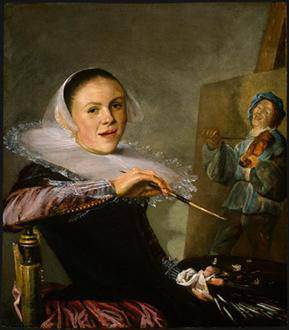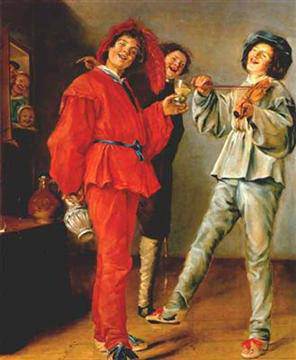
Judith Leyster (Dutch, 1609 – 1660)
Self-Portrait, c. 1632-1633, oil on canvas.
National Gallery of Art, Gift of Mr. and Mrs. Robert Woods Bliss, 1949.6.1

Judith Leyster (Dutch, 1609 – 1660)
Merry company, 1630, oil on canvas.
Louvre Museum, Paris
Judith Leyster, 1609–1660 – National Gallery, Washington
Judith Leyster’s 400th birthday will be celebrated at the National Gallery of Art with an exhibition of ten of her most engaging paintings, joined by some 20 works by 17th-century contemporaries, including her presumed teacher Frans Hals and her husband Jan Miense Molenaer, as well as musical instruments of the period depicted in the art. Judith Leyster, 1609–1660 will be on view from June 21 through November 29, 2009, in the Dutch Cabinet Galleries in the Gallery’s West Building
]]>
Leyster’s dynamic Self-Portrait (c. 1632–1633) may have been her presentation piece for entrance into the artist’s Guild of Saint Luke of Haarlem. She created a composition that emphasized her talents in two areas: portraiture and genre scenes. In the self-portrait, she sits as a dignified member of society, in a pose reflective of Frans Hals’ informal manner, as she turns toward the viewer with her arm over the chair, her warm and open expression revealing happiness. The figure on the easel is a study of the fiddler from her painting Merry Company (c.1630–1631), also included in the exhibition.
Men and women in intimate or humorous circumstances are the subjects of a number of Leyster’s genre scenes, images that reflect broader 17th-century concerns. In The Proposition (1631), a woman focused on her sewing is approached by a man who offers her coins as he touches her shoulder. This private scene, lit only by the light of an oil lamp, depicts the moment when a sexual offer has been made; however, the woman’s modest dress and body language convey that she is unwilling to participate. A more humorous nighttime encounter is depicted in A Game of Tric-Trac (c. 1631), where Leyster has created a dynamic amorous interplay among the three elegantly dressed figures. In another night scene, The Last Drop (c. 1630–1631), a skeleton holding an hourglass hovers over two joyful drinkers, providing viewers with a warning about the transience of life.
The theme of music is frequently seen in Haarlem paintings from the 1620s and 1630s, particularly by artists in Hals’ circle, including Leyster and Molenaer. Young Flute Player (c. 1635) reveals Leyster’s use of natural light to enliven her subjects within their environments. In other scenes of music-making, such as Merry Company and Concert (c. 1632–1633), Leyster captures the lightheartedness of revelry and good fellowship.
Two small panel paintings by Hals may have been part of a series depicting the five senses, now lost, with one image representing sight, in Singing Girl (c. 1626–1630), and the other representing hearing Boy Playing a Violin (c. 1626–1630).
Music serves as a central theme in Molenaer’s The Violinist (c. 1630–1635), Self-Portrait as a Lute Player (c. 1640), and The Duet (c. 1635–1636). The lute player in the last two paintings is the artist himself; in The Duet, his wife Judith strums a cittern. A 17th-century flute, a recorder, a lute, a violin, and a dance master’s fiddle on loan from private collectors, the Library of Congress, and Folger Shakespeare Library in Washington will be installed nearby.
Although no dated oil paintings are known from her later years in Amsterdam, Leyster likely painted Still Life with a Basket of Fruit around 1640. The only dated work from this period is a silverpoint and watercolor depiction of a tulip that she painted for a tulip catalogue in 1643.
Follow us on:

